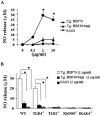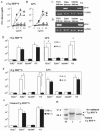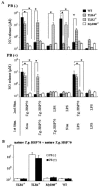Toll-like receptor 4 mediates tolerance in macrophages stimulated with Toxoplasma gondii-derived heat shock protein 70
- PMID: 16040976
- PMCID: PMC1201250
- DOI: 10.1128/IAI.73.8.4634-4642.2005
Toll-like receptor 4 mediates tolerance in macrophages stimulated with Toxoplasma gondii-derived heat shock protein 70
Abstract
Peritoneal macrophages (PMs) from toll-like receptor 4 (TLR4)-deficient and wild-type (WT) mice were responsive to recombinant Toxoplasma gondii-derived heat shock protein 70 (rTgHSP70) and natural TgHSP70 (nTgHSP70) in NO release, but those from TLR2-, myeloid differentiation factor 88 (MyD88)-, and interleukin-1R-associated kinase 4 (IRAK4)-deficient mice were not. Polymyxin B did not inhibit PM activation by TgHSP70 and nTgHSP70 from WT and TLR4-deficient mice, while it inhibited PM activation by lipopolysaccharide. Pretreatment of PMs from WT but not from TLR4-deficient mice with rTgHSP70 resulted in suppression of NO release on restimulation with rTgHSP70. Similarly, pretreatment of PMs from WT but not TLR4-deficient mice with nTgHSP70 resulted in suppression of NO release on restimulation with nTgHSP70. Polymyxin B did not inhibit rTgHSP70- and nTgHSP70-induced tolerance of PMs from TLR4-deficient mice. Furthermore, PMs from WT mice increased suppressor of cytokine-signaling-1 (SOCS-1) expression after restimulation with rTgHSP70, while those from TLR4-deficient mice did not. Phosphorylation of JNK and I-kappaBalpha occurred in rTgHSP70-induced tolerance of PMs from TLR4-deficient mice, but not in that from WT mice. These data indicated that TgHSP70 signaling mechanisms were mediated by TLR2, MyD88, and IRAK4, but not by TLR4. On the other hand, signaling of TgHSP70-induced tolerance was mediated by TLR4, and the expression of SOCS-1 suppressed the TLR2 signaling pathway.
Figures







Similar articles
-
Toxoplasma gondii-derived heat shock protein HSP70 functions as a B cell mitogen.Cell Stress Chaperones. 2002 Oct;7(4):357-64. doi: 10.1379/1466-1268(2002)007<0357:tgdhsp>2.0.co;2. Cell Stress Chaperones. 2002. PMID: 12653480 Free PMC article.
-
Involvement of MyD88 in host defense and the down-regulation of anti-heat shock protein 70 autoantibody formation by MyD88 in Toxoplasma gondii-infected mice.J Parasitol. 2002 Oct;88(5):1017-9. doi: 10.1645/0022-3395(2002)088[1017:IOMIHD]2.0.CO;2. J Parasitol. 2002. PMID: 12435148
-
TLR2 as an essential molecule for protective immunity against Toxoplasma gondii infection.Int Immunol. 2003 Sep;15(9):1081-7. doi: 10.1093/intimm/dxg108. Int Immunol. 2003. PMID: 12917260
-
Modulation of Toll-interleukin 1 receptor mediated signaling.J Mol Med (Berl). 2005 Apr;83(4):258-66. doi: 10.1007/s00109-004-0622-4. Epub 2005 Jan 21. J Mol Med (Berl). 2005. PMID: 15662540 Review.
-
A novel negative regulator for IL-1 receptor and Toll-like receptor 4.Immunol Lett. 2005 Jan 15;96(1):27-31. doi: 10.1016/j.imlet.2004.07.008. Immunol Lett. 2005. PMID: 15585304 Review.
Cited by
-
Exacerbation of murine ileitis by Toll-like receptor 4 mediated sensing of lipopolysaccharide from commensal Escherichia coli.Gut. 2007 Jul;56(7):941-8. doi: 10.1136/gut.2006.104497. Epub 2007 Jan 25. Gut. 2007. PMID: 17255219 Free PMC article.
-
Heat shock protein 70 down-regulates the production of toll-like receptor-induced pro-inflammatory cytokines by a heat shock factor-1/constitutive heat shock element-binding factor-dependent mechanism.J Inflamm (Lond). 2014 Jul 12;11:19. doi: 10.1186/1476-9255-11-19. eCollection 2014. J Inflamm (Lond). 2014. PMID: 25053922 Free PMC article.
-
A MyD88-JAK1-STAT1 complex directly induces SOCS-1 expression in macrophages infected with Group A Streptococcus.Cell Mol Immunol. 2015 May;12(3):373-83. doi: 10.1038/cmi.2014.107. Epub 2014 Nov 17. Cell Mol Immunol. 2015. PMID: 25399770 Free PMC article.
-
Communication between Toxoplasma gondii and its host: impact on parasite growth, development, immune evasion, and virulence.APMIS. 2009 May;117(5-6):458-76. doi: 10.1111/j.1600-0463.2009.02453.x. APMIS. 2009. PMID: 19400868 Free PMC article. Review.
-
Heat shock proteins: conditional mediators of inflammation in tumor immunity.Front Immunol. 2012 Apr 9;3:75. doi: 10.3389/fimmu.2012.00075. eCollection 2012. Front Immunol. 2012. PMID: 22566956 Free PMC article.
References
-
- Asea, A., M. Rehli, E. Kabingu, J. A. Boch, O. Bare, P. E. Auron, M. A. Stevenson, and S. K. Calderwood. 2002. Novel signal transduction pathway utilized by extracellular HSP70: role of toll-like receptor (TLR) 2 and TLR4. J. Biol. Chem. 277:15028-15034. - PubMed
-
- Beshay, E., F. Croze, and G. J. Prud'homme. 2001. The phosphodiesterase inhibitors pentoxifylline and rolipram suppress macrophage activation and nitric oxide production in vitro and in vivo. Clin. Immunol. 98:272-279. - PubMed
-
- Chen, C. C., K. T. Chiu, Y. T. Sun, and W. C. Chen. 1999. Role of the cyclic AMP-protein kinase a pathway in lipopolysaccharide-induced nitric oxide synthase expression in RAW 264.7 macrophages. Involvement of cyclooxygenase-2. J. Biol. Chem. 274:31559-31564. - PubMed
Publication types
MeSH terms
Substances
LinkOut - more resources
Full Text Sources
Molecular Biology Databases
Research Materials

